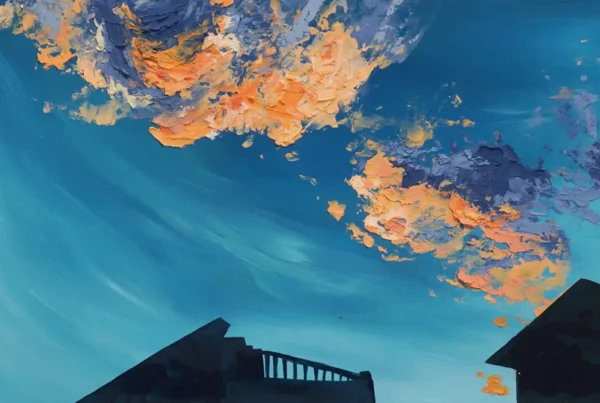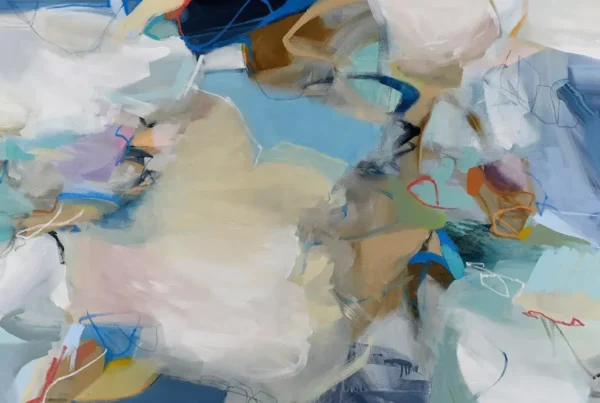“I may suddenly lash out with a color I hadn’t anticipated using. I’ll follow a shape and then another and end up with an abstraction that is absolutely right because it brings out the emotions of the subject.”
Glenna Mills: A Journey of Creative Transformation Through Art
Glenna Mills is an artist whose work reflects a lifelong journey of creative exploration and transformation. Rooted in diverse experiences—from growing up on a farm to an academic start in criminology—Mills has pursued a dynamic career in visual arts, writing, and voiceover. Her artistic voice draws from her early fascination with music and performance, extending into photography, sculpture, and painting. As she moved through these different art forms, Mills embraced the power of transformation, both in herself and in her artwork. This philosophy is deeply woven into her creations, where the intersection of traditional techniques and experimental expression reveals a rich tapestry of themes, often centered around personal history and emotional resonance.
Her artistic process, while grounded in recognizable forms, is anything but conventional. Starting with familiar subjects such as family portraits or historical figures, Mills transforms them through abstract layers of color and texture. Her work disrupts the viewer’s expectations, inviting them to engage with both the seen and the unseen, the known and the imagined. Whether through her clay sculptures or her large-scale manipulated photographs on canvas, Mills’ ability to blend the familiar with the fantastical has marked her as an artist who continually redefines her creative boundaries.
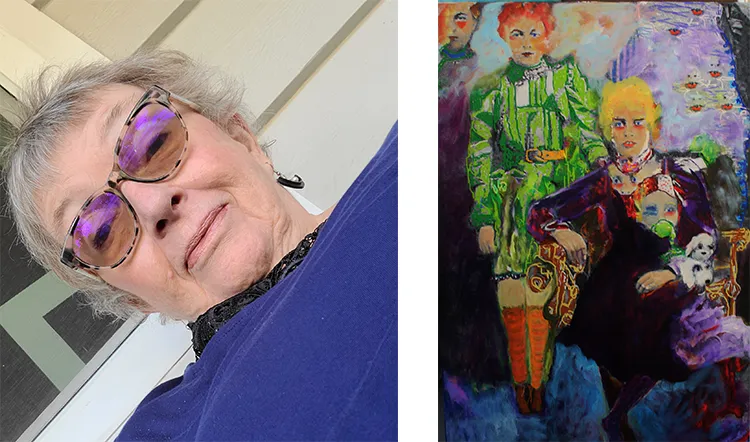
Glenna Mills: The Evolution of Artistic Expression
Mills’ artistic journey began with a shift from criminology to visual art, a transition that set the stage for her lifelong exploration of creative expression. While attending college, her interest in sociology gave way to a passion for photography and filmmaking. This shift was unplanned but profound, as Mills discovered the freedom of visual storytelling through images rather than academic theories. Photography allowed her to capture moments, but it was film that first captivated her, particularly the works of avant-garde filmmakers like Stan Brakhage and Michael Snow. Their experimental approaches inspired her to push past conventional narratives and explore the abstract, meditative potential of visual art.
Mills continued to explore these ideas as she enrolled in a Master of Fine Arts program in film, where she developed a fascination with movement and abstraction within visual media. However, it wasn’t long before her attention shifted again—this time to sculpture, where the tactile nature of working with clay offered a new form of artistic release. Through sculpture, she was able to engage directly with the materials, shaping and molding them in real time, which contrasted with the often slow and technical process of filmmaking. This hands-on approach allowed her to explore themes of transformation and hybridity, creating surreal creatures that often carried symbolic meanings, like her clay sculpture Going West, which portrays a horse carrying women of the night.
Her move from film to sculpture didn’t signify the end of her interest in photography, but rather, a deeper investigation into the ways visual art can communicate complex stories. The transition between these mediums is reflective of Mills’ overall artistic philosophy—one that values fluidity and evolution over static representation.
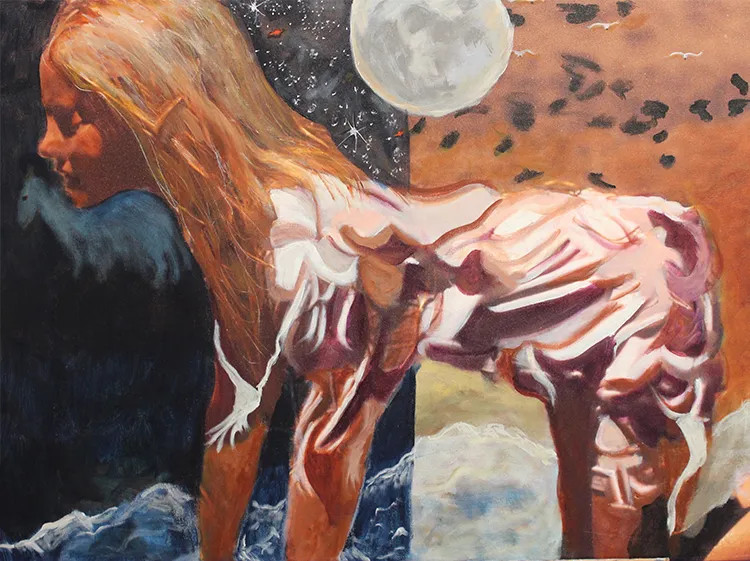
The Power of Reimagined Photographs
In recent years, Glenna Mills’ work has centered around the manipulation of old family photographs, a practice that began after she sold her kiln and transitioned fully into painting. This new focus on photography and painting was sparked during a period of physical recovery, during which she found herself drawn to the vast collection of ancestral photographs she had amassed. These images, often sepia-toned or faded by time, held a wealth of untold stories. Mills began digitally manipulating the photographs, infusing them with her own artistic vision by altering facial features, adding imaginative elements, and reinterpreting their clothing and surroundings.
This process of transformation was not just about aesthetics; it was also deeply emotional for Mills. By transferring these altered images onto canvas and continuing to paint over them, she was able to breathe new life into the forgotten faces of her ancestors. Each portrait became a narrative, infused with the stories of those who came before her, as well as Mills’ personal interpretation of their lives. Her painting Bygone Days, for instance, blends the image of a family home with abstracted representations of the people who once lived there, creating a visual dialogue between past and present.
Through this reimagining of old photographs, Mills touches on universal themes of memory, identity, and legacy. Her work invites viewers to reflect on their own connections to the past, while also challenging the idea that history is fixed or immutable. In Mills’ hands, these photographs are not mere records of the past; they are dynamic canvases for exploring the fluidity of time and emotion.
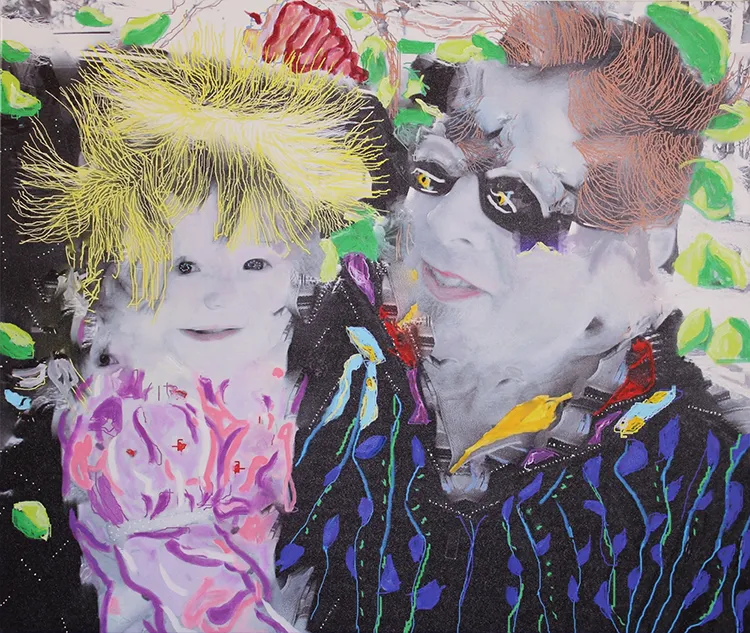
Glenna Mills: The Artistic Balance of Instinct and Precision
Mills’ artistic process is deeply intuitive, a dance between control and spontaneity. She describes her approach as one of trusting her hands to lead the way, whether in clay or on canvas. This trust in the physical act of creation is central to her work, allowing her to tap into emotions and subconscious thoughts that might otherwise remain hidden. Yet, with this freedom comes the challenge of balance—Mills constantly navigates the tension between her instinctual choices and the need for precision in her craft. This delicate balance is evident in her sculptures, where forms emerge from the clay organically, only to be shaped and refined as the piece develops.
In her painting, Mills faces similar challenges. Working on large canvases allows her to follow unexpected impulses, such as the sudden introduction of a bold, unanticipated color or the evolution of a shape into a new abstraction. These moments of unpredictability are both exhilarating and daunting for the artist, who often struggles with the fear of “ruining” a piece just as it begins to come together. Yet it is precisely this willingness to embrace risk that has fueled some of her most successful work. By allowing herself the freedom to follow these outbursts of creativity, Mills uncovers the emotional depth of her subjects, pushing her work beyond the literal into the expressive.
Despite her successes, Mills acknowledges the practical realities of life as an artist. She works without the benefit of a large studio space or a dedicated assistant to handle the business side of her career. Instead, she relies on the support of her husband, who helps with the logistics of transporting and selling her work. This partnership has allowed Mills to focus on the creative aspects of her practice, even as she navigates the challenges of self-promotion and exhibition. Ultimately, it is her determination and passion for her craft that drive her forward, ensuring that her work continues to evolve and resonate with those who encounter it.




